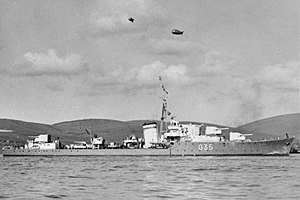HMS Marne was an M-class destroyer of the Royal Navy commissioned on 2 December 1941. She was built by Vickers-Armstrongs at High Walker Yard, Newcastle-upon-Tyne, England, and saw service in the Atlantic theatre of World War II.
 Marne in May 1942
| |
| History | |
|---|---|
| Name | HMS Marne |
| Builder | Vickers-Armstrong, Newcastle upon Tyne |
| Laid down | 23 October 1939 |
| Launched | 30 October 1940 |
| Commissioned | 2 December 1941 |
| Fate | Sold to the Turkish Navy on 26 March 1959, renamed Mareşal Fevzi Çakmak |
| Name | Mareşal Fevzi Çakmak |
| Namesake | Fevzi Çakmak |
| Acquired | 26 March 1959 |
| Fate | Discarded, 1970 |
| General characteristics (as built) | |
| Class and type | M-class destroyer |
| Displacement | |
| Length | 362 ft 3 in (110.4 m) (o/a) |
| Beam | 37 ft (11.3 m) |
| Draught | 14 ft (4.3 m) |
| Installed power |
|
| Propulsion |
|
| Speed | 36 knots (67 km/h; 41 mph) |
| Range | 5,500 nmi (10,200 km; 6,300 mi) at 15 knots (28 km/h; 17 mph) |
| Complement | 190 |
| Sensors and processing systems | |
| Armament |
|
Service history
editRoyal Navy
editMarne was part of Convoy PQ 15 and along with Martin, helped to rescue 169 survivors from Punjabi after she was sunk in a collision with the battleship King George V.
The destroyer depot ships Hecla and Vindictive with the escort ships Venomous and Marne, were part of a convoy as part of Operation Torch west of Gibraltar. On 12 November 1942 the German submarine U-515 torpedoed and sunk Hecla, and minutes later fired two more torpedoes and badly damaged Marne, blowing off her stern. Michael Flanders, who was to become a famous actor and writer, was serving on board as part of the Royal Navy Volunteer Reserve
Turkish Navy
editFollowing the Second World War Marne, along with three other ships of the same class, was transferred to the Turkish Navy as part of an agreement signed at Ankara on 16 August 1957. They underwent a refit which involved the removal of the after set of torpedo tubes and some secondary armament. They received a new deckhouse and Squid anti-submarine weapons system. On 29 June 1959 they were handed over at Portsmouth. Marne was renamed Mareşal Fevzi Çakmak, after Fevzi Çakmak (1876–1950), the Turkish Mareşal (Field Marshal) and Chief of Staff of the Armed Forces.[1]
The ship remained in service with the Turkish Navy until 1970, when she was discarded and scrapped.
Notes
edit- ^ Blackman, Raymond V B, Jane's Fighting Ships 1963-4, Sampson Low, Marston & Co. Ltd, London, p248
References
edit- Colledge, J. J.; Warlow, Ben (2006) [1969]. Ships of the Royal Navy: The Complete Record of all Fighting Ships of the Royal Navy (Rev. ed.). London: Chatham Publishing. ISBN 978-1-86176-281-8.
- English, John (2001). Afridi to Nizam: British Fleet Destroyers 1937–43. Gravesend, Kent: World Ship Society. ISBN 0-905617-64-9.
- Friedman, Norman (2006). British Destroyers & Frigates: The Second World War and After. Annapolis, Maryland: Naval Institute Press. ISBN 1-86176-137-6.
- Lenton, H. T. (1998). British & Empire Warships of the Second World War. Annapolis, Maryland: Naval Institute Press. ISBN 1-55750-048-7.
- Lyon, Hugh & Chumbley, Stephen (1995). "Turkey". In Chumbley, Stephen (ed.). Conway's All the World's Fighting Ships 1947-1995. Annapolis, Maryland: Naval Institute Press. ISBN 1-55750-132-7.
- March, Edgar J. (1966). British Destroyers: A History of Development, 1892–1953; Drawn by Admiralty Permission From Official Records & Returns, Ships' Covers & Building Plans. London: Seeley Service. OCLC 164893555.
- Rohwer, Jürgen (2005). Chronology of the War at Sea 1939–1945: The Naval History of World War Two (Third Revised ed.). Annapolis, Maryland: Naval Institute Press. ISBN 1-59114-119-2.
- Whitley, M. J. (1988). Destroyers of World War 2: An International Encyclopedia. Annapolis, Maryland: Naval Institute Press. ISBN 0-87021-326-1.
External links
edit